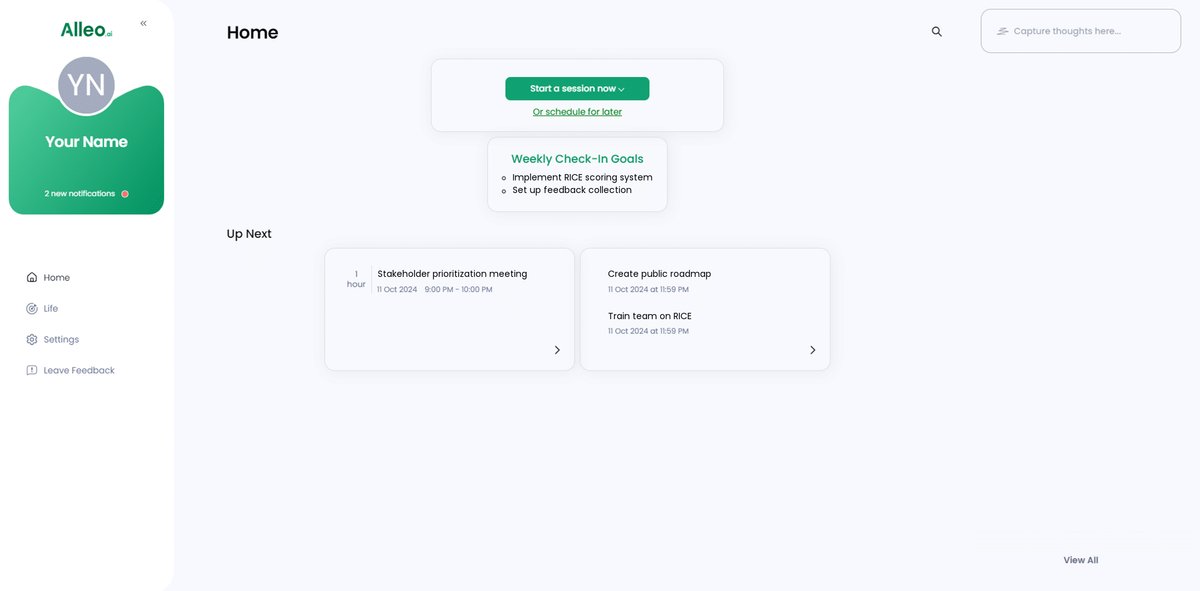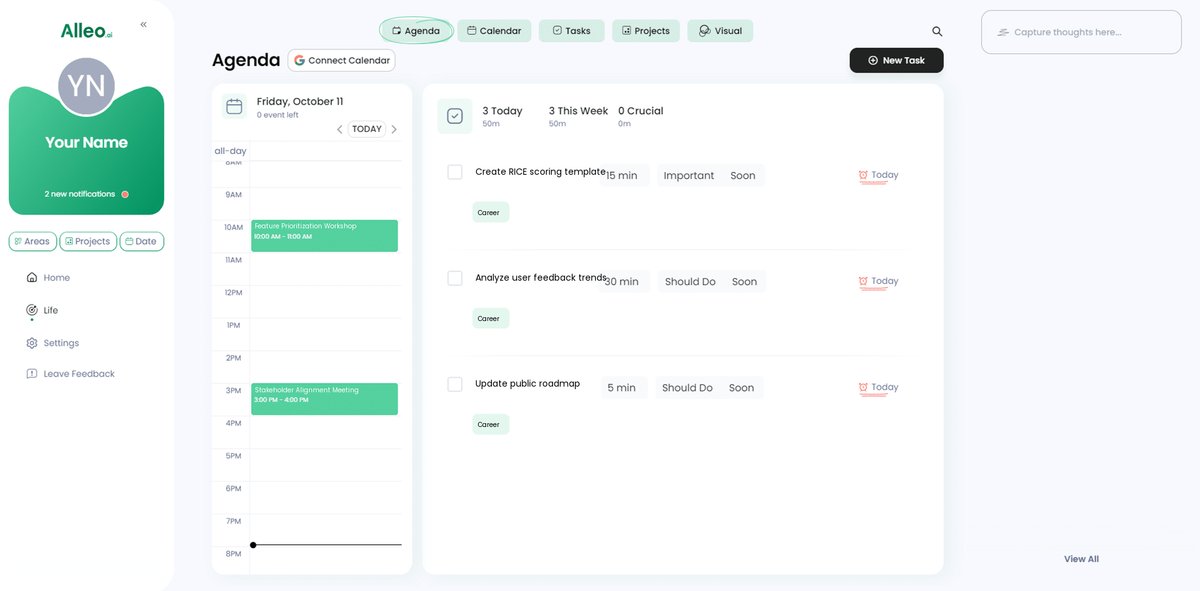How to Prioritize Feature Requests: 5 Essential Strategies for SaaS Product Managers
Are you overwhelmed by numerous feature requests from early users and partner companies, struggling to determine which ones to prioritize for development? Prioritizing SaaS feature requests can be a daunting task for product managers.
As a life coach, I’ve helped many professionals navigate these challenges. In my experience working with SaaS product managers, I often encounter similar struggles with feature prioritization techniques and product backlog management.
In this article, you’ll discover proven strategies to effectively prioritize feature requests, balancing user demands, business goals, and technical feasibility. We’ll cover actionable techniques like implementing the RICE prioritization framework and creating structured feedback systems for customer feedback analysis. You’ll learn how to use tools such as user story mapping and the impact vs effort matrix to inform your SaaS product roadmap.
Let’s dive into data-driven decision making for SaaS features and stakeholder alignment in product management.

Understanding the Feature Prioritization Dilemma
When you’re bombarded with feature requests, it’s easy to feel overwhelmed. Without a clear strategy for prioritizing SaaS feature requests, you risk wasting resources on less impactful features.
I’ve seen many SaaS product managers struggle with balancing user demands, business goals, and technical feasibility when managing their product backlog. In my work, I often find that not having a structured prioritization approach leads to missed opportunities and frustrated teams.
Imagine constantly juggling competing interests without a clear direction for your SaaS product roadmap. This chaos can be detrimental, causing delays and misalignment with your company’s goals.
It’s crucial to develop a strategy that weighs various factors, such as using an impact vs effort matrix or the RICE prioritization framework, ensuring that you focus on what truly matters when prioritizing SaaS feature requests.
Over time, I’ve observed that a lack of prioritization can lead to significant inefficiencies in product management. But don’t worry, you’re not alone in this struggle with feature prioritization techniques.

Your Roadmap to Effective Feature Prioritization
Overcoming this challenge of prioritizing SaaS feature requests requires a few key steps. Here are the main areas to focus on to make progress:
- Implement RICE scoring for feature evaluation: Define Reach, Impact, Confidence, and Effort to score features effectively using the RICE prioritization framework.
- Create a structured feedback collection system: Use tools for customer feedback analysis to gather and categorize user feedback systematically.
- Conduct regular stakeholder prioritization meetings: Schedule recurring meetings with clear agendas to align on priorities, improving stakeholder alignment in product management.
- Use data analytics to measure feature impact: Leverage analytics tools for data-driven decision making for SaaS features to assess feature performance and inform decisions.
- Develop a public roadmap for transparency: Create and share a visual SaaS product roadmap, updating it regularly based on feedback and user story mapping.
Let’s dive in!
1: Implement RICE scoring for feature evaluation
Implementing the RICE scoring method is crucial for effectively evaluating and prioritizing SaaS feature requests. This feature prioritization technique aids in managing your product backlog and shaping your SaaS product roadmap.
Actionable Steps:
- Define the RICE framework components: Reach, Impact, Confidence, and Effort. Create a template for scoring features, which is essential for data-driven decision making for SaaS features.
- Conduct a workshop to train your team on the RICE framework. Provide examples and practice scenarios to ensure understanding, promoting stakeholder alignment in product management.
- Consistently apply RICE scoring to new feature requests. Review and update scores regularly as new data becomes available, incorporating customer feedback analysis.
Explanation:
These steps ensure a structured approach to feature evaluation, helping you prioritize effectively. Using the RICE prioritization framework provides a balanced view by considering multiple factors, similar to an impact vs effort matrix.
This method is widely recognized in the industry for its comprehensive approach to feature prioritization. For more details on effective scoring methods, visit Userpilot’s feature prioritization guide.
Key benefits of RICE scoring include:
- Objective decision-making based on quantifiable metrics
- Improved alignment between teams on feature priorities, supporting agile feature prioritization
- More efficient resource allocation for development efforts
This structured scoring system will help you make informed decisions and align with your product goals when prioritizing SaaS feature requests.

2: Create a structured feedback collection system
Creating a structured feedback collection system is essential for capturing valuable user insights and driving informed decisions when prioritizing SaaS feature requests.
Actionable Steps:
- Implement in-app feedback forms and surveys: Add feedback forms within your app to collect user opinions in real-time, aiding in SaaS product roadmap development.
- Organize feedback by themes and urgency: Use a tool to categorize and tag feedback to make it actionable, supporting effective product backlog management.
- Analyze feedback regularly: Schedule sessions to review feedback trends and update your backlog accordingly, employing customer feedback analysis techniques.
Explanation:
These steps help ensure you systematically gather and analyze user feedback, aligning your product roadmap with user needs and facilitating data-driven decision making for SaaS features.
Regularly reviewing and organizing feedback helps prioritize features that offer the most value, utilizing feature prioritization techniques. For more detailed guidance, visit AnnounceKit’s feature request tips.
A robust feedback system is crucial for staying responsive to your users’ needs and effectively prioritizing SaaS feature requests.

3: Conduct regular stakeholder prioritization meetings
Conducting regular stakeholder prioritization meetings is crucial for aligning on priorities and ensuring everyone is on the same page when prioritizing SaaS feature requests.
Actionable Steps:
- Schedule recurring prioritization meetings: Set a monthly or bi-weekly cadence for meetings. Include key stakeholders from product, engineering, marketing, and customer success to discuss the SaaS product roadmap.
- Create a clear agenda and criteria: Define criteria for prioritization discussions. Use structured formats like RICE prioritization framework or impact vs effort matrix to guide conversations.
- Document and communicate decisions: Record meeting outcomes and decisions. Share updates with the broader team to ensure alignment and effective product backlog management.
Explanation:
These steps help align priorities across different teams, ensuring that decisions are made collectively and transparently. Regular meetings foster collaboration and keep everyone focused on common goals in prioritizing SaaS feature requests.
According to Rapidr, structured prioritization frameworks like RICE can significantly improve decision-making processes by providing clear criteria. This approach ensures that all voices are heard and that the product roadmap reflects the most critical needs based on customer feedback analysis.
Best practices for effective stakeholder meetings:
- Prepare and distribute relevant data before the meeting for data-driven decision making for SaaS features
- Encourage open discussion and debate on feature priorities using agile feature prioritization techniques
- Set clear action items and follow-up tasks for each meeting to maintain stakeholder alignment in product management
Regular stakeholder meetings streamline the prioritization process, reducing confusion and keeping the team aligned when prioritizing SaaS feature requests.

4: Use data analytics to measure feature impact
Using data analytics to measure feature impact is essential for prioritizing SaaS feature requests and making informed decisions to optimize resource allocation.
Actionable Steps:
- Integrate analytics tools: Connect platforms like Google Analytics, Mixpanel, or Amplitude to track key metrics for your SaaS product roadmap.
- Run A/B tests: Design experiments to compare feature variations and assess their effects on user behavior, enhancing your feature prioritization techniques.
- Review analytics dashboards regularly: Continuously monitor data to adjust prioritization based on performance insights, improving your product backlog management.
Explanation:
These steps help you leverage data-driven decision making for SaaS features, aligning them with user needs and business goals.
According to Rapidr, using data-driven approaches like A/B testing enhances the accuracy of feature prioritization.
Embracing data analytics ensures your product evolves based on real user engagement and performance metrics, supporting agile feature prioritization.
Adopting these practices will transform your prioritization process for SaaS feature requests, leading to more successful product outcomes.
5: Develop a public roadmap for transparency
Developing a public roadmap is vital for maintaining transparency and managing user expectations effectively when prioritizing SaaS feature requests.
Actionable Steps:
- Create a visual roadmap: Use tools like Trello or Productboard to outline key milestones and feature releases in your SaaS product roadmap.
- Engage with your community: Share the roadmap on your website and social media. Encourage users to provide feedback and vote on features, enhancing customer feedback analysis.
- Update the roadmap regularly: Reflect changes based on user story mapping and internal decisions. Communicate updates clearly to manage expectations and support agile feature prioritization.
Explanation:
These steps ensure that your users are informed and involved in the development process, fostering trust and engagement. A transparent roadmap helps align your team’s efforts with user needs and business goals, supporting data-driven decision making for SaaS features.
According to ProdCamp, implementing public roadmaps can enhance transparency in feature development and build stronger relationships with your user base.
Key elements of an effective public roadmap:
- Clear timeline with upcoming feature releases, reflecting your feature prioritization techniques
- Status indicators for each feature (planned, in progress, completed) to aid product backlog management
- Mechanism for users to provide feedback or vote on features, supporting stakeholder alignment in product management
A well-maintained public roadmap keeps your users engaged and informed, ultimately contributing to product success and effective prioritization of SaaS feature requests.

Partner with Alleo on Your Feature Prioritization Journey
We’ve explored the challenges of prioritizing SaaS feature requests and how solving them can streamline your SaaS product management. But did you know you can work directly with Alleo to make this journey easier?
Setting up an account with Alleo is simple and fast. Create a personalized plan tailored to your specific needs, including your SaaS product roadmap and feature prioritization techniques.
Alleo’s AI coach will guide you through implementing RICE prioritization framework, organizing stakeholder meetings for alignment in product management, and more. You’ll receive follow-ups on your progress, reminders to stay on track, and actionable insights via text and push notifications to support your data-driven decision making for SaaS features.
Ready to get started for free? Let me show you how to begin prioritizing SaaS feature requests effectively!
Step 1: Log In or Create Your Account
To begin your feature prioritization journey with Alleo, log in to your existing account or create a new one in just a few clicks, setting the foundation for streamlined product management.

Step 2: Choose Your Feature Prioritization Goal
Select “Setting and achieving personal or professional goals” to focus on improving your feature prioritization skills. This goal directly addresses the challenges discussed in the article, helping you streamline your product management process and make more informed decisions about which features to prioritize.

Step 3: Select “Career” as Your Focus Area
Choose “Career” as your focus area to tackle feature prioritization challenges head-on, aligning your professional goals with effective product management strategies for better decision-making and career growth.

Step 4: Starting a coaching session
Begin your journey with Alleo by scheduling an intake session, where you’ll discuss your feature prioritization challenges and set up a personalized plan to implement the strategies outlined in this article, such as RICE scoring and stakeholder meetings.

Step 5: Viewing and Managing Goals After the Session
After your coaching session, check the app’s home page to review and manage the feature prioritization goals you discussed, allowing you to track progress and stay aligned with your product roadmap.

Step 6: Adding events to your calendar or app
Use the AI coach’s calendar integration to schedule prioritization meetings, feedback review sessions, and roadmap updates, allowing you to track your progress in solving feature prioritization challenges directly within the app.

Your Path to Effective Feature Prioritization
Addressing feature prioritization for SaaS products can feel daunting, but you’re not alone.
By implementing these strategies for prioritizing SaaS feature requests, you can balance user demands, business goals, and technical feasibility. Start with RICE prioritization framework, structured customer feedback analysis, and regular stakeholder alignment meetings.
Leverage data-driven decision making for SaaS features and maintain a public SaaS product roadmap for transparency.
These feature prioritization techniques will transform your approach, leading to better product outcomes.
Remember, you can always rely on Alleo for support in product backlog management.
Try Alleo for free and experience streamlined feature prioritization for your SaaS product.
You’ve got this. Let’s achieve product success together through effective agile feature prioritization.